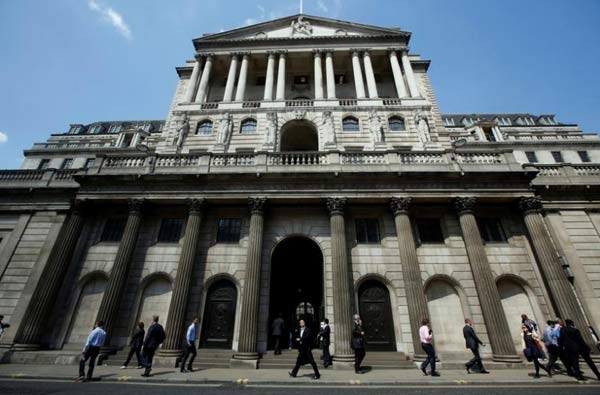Bank of England considered bigger increase to banks' risk buffer last week
 |
|
Pedestrians walk past the Bank of England in the City of London, Britain, May 15, 2014. [Photo/Agencies] |
LONDON - The Bank of England considered raising banks' capital requirements last week by more than it had previously signalled to tackle risks to the financial system including those from Brexit, the BoE said on Tuesday.
Britain's banks have had to triple the capital they hold as a cushion against potential losses since the 2007-09 financial crisis which plunged the country into a recession, and the BoE is keen to ensure they are well-protected against future risks.
Last week the BoE increased British banks' counter-cyclical capital buffer to 1 percent from 0.5 percent.
That was in line with a previous plan which aimed to ensure banks had enough capital at what the BoE sees as the mid-point of a lending cycle.
However, a record of the BoE Financial Policy Committee's meetings running up to the decision showed that they considered raising it higher.
Annual stress tests of British banks last week showed that they could cope with a "disorderly" Brexit - but not if it coincided with a deep global recession and further significant fines for financial misconduct.
"There were clear benefits to requiring banks to maintain additional capital," the BoE said, summing up the case for raising the risk buffer above 1 percent.
"On the other hand, the likelihood of a disorderly Brexit occurring in combination with both a severe global recession and very substantial additional conduct costs could be seen as extremely remote," the BoE said.
The central bank was also concerned that going against previous guidance that it would increase the CCyB only to 1 percent in November would surprise banks and financial markets.
"This could undermine the effectiveness of future communications," the BoE said.
It reiterated that it would look again at the level of the CCyB in the first half of 2018. The buffer is intended to rise and fall over the course of the credit cycle, to ensure that banks do not over-lend during a boom and do not need to cut lending excessively in a downturn.
The BoE had warned of the potential costs of Brexit before the June 2016 referendum, drawing ire from Brexit supporters who said Governor Mark Carney was politicising the central bank. The BoE says its mandate requires it to talk about where it sees economic risks.
The BoE also said on Tuesday that it had warned England's High Court earlier this year to be ready for a rush of legal applications from insurers seeking to change millions of contracts ahead of Brexit.
The BoE said early estimates suggested that British policyholders held contracts worth at least 20 billion pounds with European insurers, while Europeans held 40 billion pounds of cover with British firms.
The BoE has previously said new legislation would be the best way to handle existing cross-border insurance contracts over the Brexit period.
















